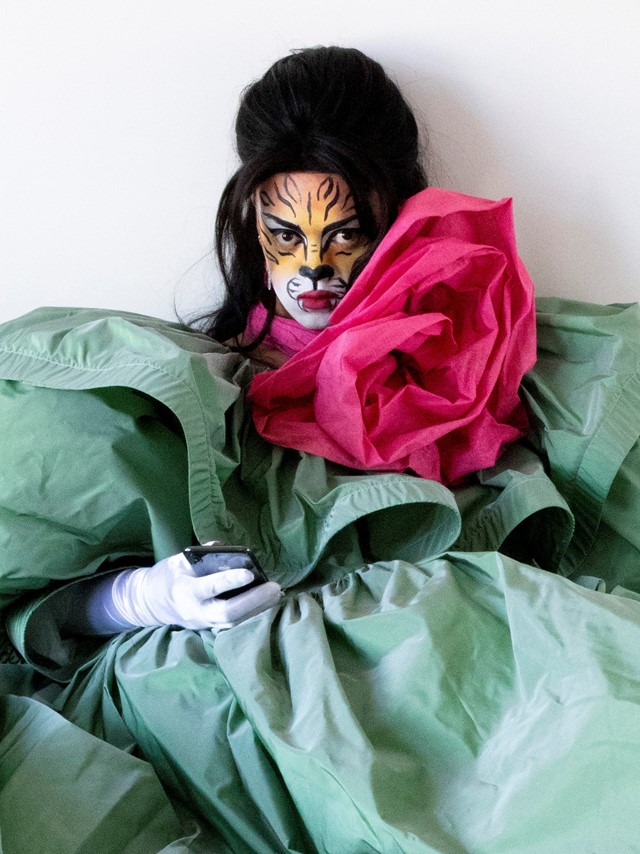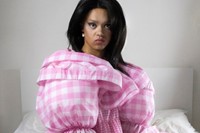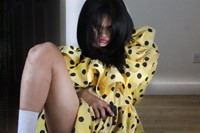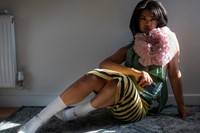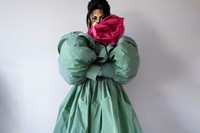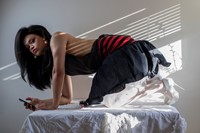“I just want to make something that is a feast for the eyes, for my own interest,” says designer and image-maker Joseph Lokko of his deeply personal fashion image-making practice
There’s a wall in Joseph Lokko’s bedroom in London you can’t see, veiled by an overpopulated floor-to-ceiling clothing rail. On its flimsy frame warped by weight, the rail bears some of the most fantastical, voluminous garments in polka-dots, stripes and taffetas – puffed, ruffled and constructed by Lokko in that same bedroom. “I’m so scared sometimes it’s just going to collapse, and the whole rail is going to come down. Like a salad of dresses on my floor.” Ornate as they are, the garments have never left the house. Instead, in an ongoing, solitary series of self-portraits, he captures them on a version of himself, transformed by hair, make-up and clothing, and lensed on his DSLR compact camera. “I just want to make something that is a feast for the eyes, for my own interest,” he says. “I don’t even care if anyone else looks at this. I’m going to be happy that I did it.”
The 25-year-old image-maker graduated from Central Saint Martins in 2020 after studying fashion communication. An all-important year of final projects was made difficult for many creative students in light of the strict lockdowns; design students lost access to the university resources, and photographers couldn’t meet with subjects to lens. These, however, weren’t obstacles for Lokko. “I feel very lucky in a lot of ways because my work isn’t contingent on me being around other people, so I really enjoyed just literally treating it like I was doing a residency in my bedroom.” His final project at university, titled Lokko, visualised his youth growing up mixed-race in the predominantly white English town of Hemel Hempstead, and referenced the twisted, sometimes camp pageantry of grief and mourning. Concealed from head-to-toe in his own highly stylised costuming made from cheap pinned fabrics and repurposed objects, Lokko photographed himself in a cinematic yet ominous series of images, setting the groundwork for his one-man-band method of deeply personal fashion image-making. Lokko soon caught the attention of Christopher and Tammy Kane of British fashion brand Christopher Kane; Lokko shot a series of self-portraits for the label’s glittering 2020 Festive Collection campaign, in an ode to glamour during lockdown.
Welcoming the viewer back into his domestic self-portraiture once more, this yet-to-be-titled series sees a decorated Lokko “cross-dressing” at home in outfits inspired by an unusual amalgam of 1980s Yves Saint Laurent, Victorian dresses for dolls, and John Singer Sargent paintings. The elaborate costuming would swallow him if not for his commanding gaze and poses. “I like that with friction between this person that looks like they’re trying really hard, but they’re literally just in their house, performing to an audience of nobody.” There’s a strange, sexual nuance to the images, which he owes to the referencing of the often secretive and fetishistic online cross-dressing communities on Flickr. With these in mind, Lokko threads together themes and motifs before rendering them with his own gaudy taste. “I love [the images from Flickr] because a lot of them feel like they’re in suburban homes. There’s these amazing outfits that are in the back of a cupboard somewhere, apart from when they’re part of their images.”
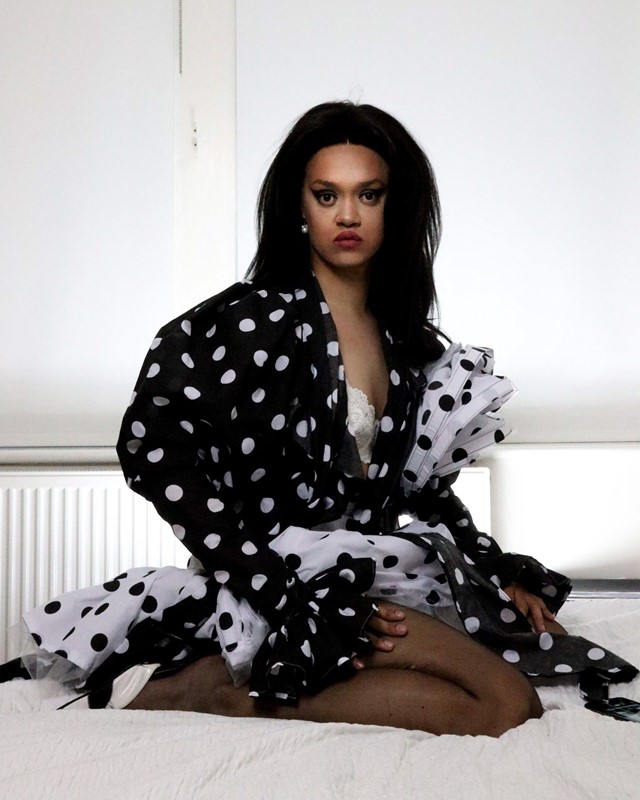
The iPhone is a recurring motif throughout the series, adding layers of modern narcissism – in outlandish costumes from a different era, the person in the pictures seems very much grounded in our selfie-obsessed present day. Yet, this is purely coincidental. “I use my phone as the remote shutter, so I can watch myself take the pictures. In all the images my phone is hidden somewhere if it’s not visible.” Also pictured in the foreground and background are tokens that give away secrets of who the glamazon may be: a pouch of tobacco, a hairbrush, some Swan extra-slim filters. Again, these are coincidental. “I think it’s funnier and it grounds it in more reality if I don’t hide or airbrush out certain things. I’ve created the situation and now I’m just sitting in it, taking pictures the whole time.” Referencing panopticon prisons – where inmates can’t see that they’re being watched, so they constantly behave like they are – Lokko weaves in a voyeuristic, unsettling sensation of surveillance, of being constantly caught in the act.
All the while, some viewers see the images in essence as a man wearing a dress instead of valuing the artistic expression behind them. Distracted by their own misunderstandings of the nuances of gender expression, Lokko opens the floodgates for assumption. “People do see it as fetish imagery sometimes. I have gotten a lot of DMs from interested parties, and some of the shit they say is wild. It doesn’t bother me because I’m so detached from my image in those pictures, so it’s like they’re talking to someone else.” A younger generation, influenced by the rising cultural appreciation for drag, often wrongly assumes Lokko is a queen. In reality, it’s the love of dresses and fashion imagery that drives him creatively.
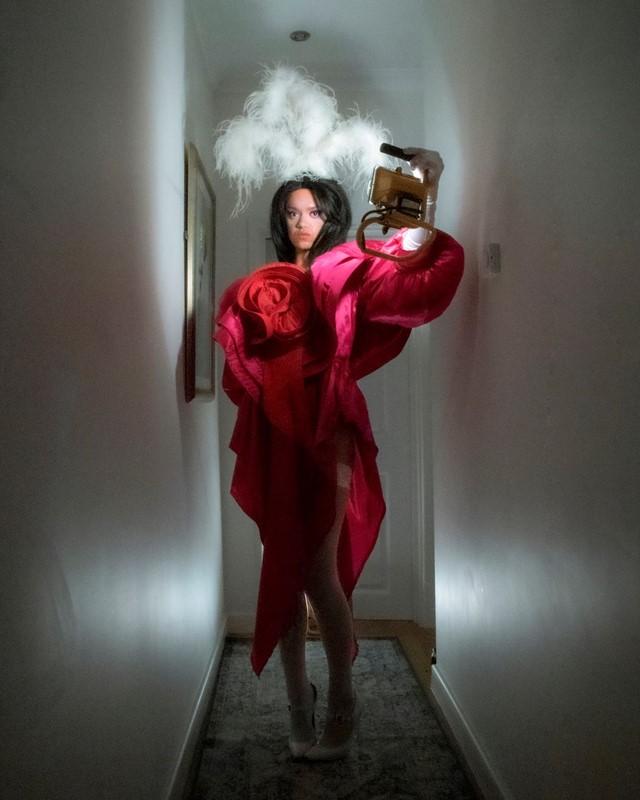
Asked about his ambitions for the series and clothing, he’s reminded of a Penny Goring artwork he recently spotted at an exhibition at the ICA. “There was this one image that was like, ‘I don’t have a goal. I have an explicable yearning.’ I’m just kind of seeing where it goes. I find it fun to do, and it actually just makes me excited about fashion as a whole.” With the series, Lokko creates an eye-opening body of work, empowering a very singular sense of creativity extending far beyond simply blurring the gender binaries. By creating work he loves, the series and archive of clothing continues to grow, in both quantity and ambitious silhouette. “I’m a hoarder. Some of these dresses are made of such synthetic fabric, I think they would last until the day the world ends. If any of these hit landfill, it’s over for the seagulls.”
